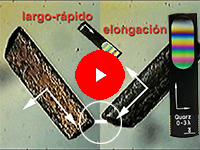

This is the relationship between the three dimensions of the crystal and the magnitude of the refractive indices corresponding to them.
We are trying to determine whether the slow or fast component is vibrating in the longest direction of the crystal. If the slow component vibrates in the longest direction of the mineral, the mineral is said to have a positive sign of elongation or is "length-slow". On the other hand, if it has a negative sign of elongation it is called "length-fast".
In order to determine the sign of elongation, a compensator is used (slide or wedge; preferably the slide) and we observe whether the interference colour of the mineral gets higher or lower.
The compensator has its fast component vibrating in the longest direction and is introduced at 45° to the directions in which the nicols are vibrating.
The mineral is situated in the extinction position (i.e. its directions of vibration coincide with those of the polariser and analyser, E-W and N-S) and is then turned 45° so that the longest dimension of the mineral is situated in the same direction as the compensator (so that their directions of vibration coincide). The compensator is then introduced and the change in colour is observed. If the colour gets lower, the mineral has a positive sign of elongation, or "length-slow" (the fast component of the compensator has coincided with the slow one of the mineral). If the interference colour gets higher, the mineral is "length-fast". It is often a good thing to turn the crystal another 90°, and determine the change in colour again. By comparing the changes in colour of the mineral in the two positions (at 45° and 45°+90°) it is easy to identify the position in which the colour gets higher or lower.
Index | Introduction | PPL | XPL ortos | Top